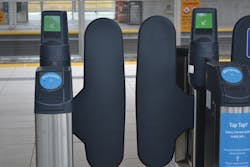For about as long as mass transit has existed, the bane of fare evaders has been around and causing issues for agencies.
A lot of different tactics have been tried throughout the years and technology has allow for new ways to fight fare evasion. However, due to all the different issues that surround fare evasion, transit agencies across the globe are finding no one common solution to fit their needs.
Policing riders
Doug Kelsey, chief operating officer for TransLink in Vancouver, B.C., said transit police and security are patrolling the transit system in Metro Vancouver and part of their duties include checking fares. If someone is found to have not paid, they’re subjected to a $173 fine, which can increase if not paid.
He said the Province of British Columbia recently approved legislation that enables TransLink to send the accounts of people who don’t pay their outstanding fines to a collection agency and/or to the provincial auto insurer to refuse to insure or renew their driver’s license. Between September 2012 — when the legislation went into effect — and March 2013, Translink conducted over 1.1 million fare inspections and issued about 18,700 tickets.
While inspections were up, Kelsey said the number of tickets issued was down compared to the year before, which suggests that more people now pay their fares on the transit system. He said transit agency officials conclude this is due to people being more aware due to social media and traditional media; increased enforcement and the serious consequences that follow being caught not paying fares.
“With the full implementation of TransLink’s new fare gate and Compass Card system in 2014, we expect to recover approximately $5.2 million in lost revenue annually,” he said. “The fare gates and mobile validators on buses automatically calculate the correct fare and as a result, reduce accidental fare evasion by honest customers. The fare gates will also act as a physical barrier for accessing the SkyTrain system, deterring those who attempt to evade fare.”
Benedicte Guenot, director for international marketing projects for Keolis said the company conducts regular surveys to analyze new travelling behaviors and better understand passengers. The latest survey done in 2012 in France, revealed that 54 percent of commuters have committed fare evasion at least once in the past year. Besides broken ticket machines, their excuses included low risk of getting caught, no change to buy a ticket lost tickets, etc. There are different types of fare evaders and all of them need to be addressed.
In order to fight fare evasion, Guenot said everyone in the company needs to be involved in order to create a ticketing system that’s easy to use and understand with multiple channels to purchase passes; and marketing campaigns to remind people to renew passes well before they expire or if they don’t have a pass, to encourage riders to use them or automatic payments.
He said it also important to develop an efficient control system with inspectors to and to encourage fare evaders to subscribe to a pass or face enforcement penalties because fare evasion will go down if people know they will have to pay.
“Each of these elements is important but none is sufficient on its own,” Guenot stated. “While enforcement is an important aspect of ensuring compliance, it must be part of a broader suite of measures designed to create a culture of fare compliance. This culture should make it easy to do the right thing and difficult to do the wrong thing.”
Gating remains popular
In gated systems, the operators have recovered revenues previously lost to fare evasion and they are using the data collection from their fare collection systems to reallocate resources more efficiently. The trend is definitely set to continue. Operators are increasingly recognizing the real benefits – in revenue collection, security, passenger safety and improved environment – which they gain from a gated system. The barriers to gating have continued to fall.
Matt Cole, executive vice president, strategy, business development and diversification for Cubic Transportation Systems, said on project that company has been involved with, gating has been shown to be effective at mitigating fare evasion, reducing crimes by 34 percent on average.
He said operators of mass transit rail systems around the world have employed varying philosophies and operational solutions to fare collection. Variables in the gating debate include passenger traffic volume, station configurations, operating culture, economic perspectives, and historical practice.
There has also been a number and variety of feasible business cases for operation that have been developed for various transportation agencies over the years. The result has been a tendency for larger heavy rail operators to deploy gates and regional commuter and light rail systems to embrace Proof of Purchase models.
“The existing operating culture of the agency is a key consideration,” he said. “Operators of an ungated system can believe that Proof of Purchase (POP) is more efficient based on the belief that customers can board without the intermediary step of obtaining a ticket, tapping a gate or farebox. However, the downside is that the labor involved in checking every customer is cost prohibitive, and without checking every customer ticket or fare card, two things happen: potential revenue is lost and important data about passenger loads are not captured.
“Customer reaction is a second challenge, because people have mixed feelings when gating is deployed,” he said.
Cole contends studies prove gating works and can reduce annual crime rates on an average of 34 percent.
“As to the customer behavior challenge, in ungated systems people see that others aren’t paying and cheating the system, which they find annoying and recognize as bad business for the operator. It also makes people more lax about paying themselves, and gives some a feeling that they are missing an opportunity to save money by being so honest,” Cole stated. “These emotions help to offset the adverse feelings they have when gating is deployed, because they generally see gating as necessary given the presence of so many people who cheat the system.”
When gating is deployed, Cole said communication with riders is essential to get them to understand the need to add it to the system and how honest riders are subsidizing those who don’t pay their way. He said those who see an improvement in service will then also be willing to pay a little more for their journey.
“Innovations in ticketing technology including the arrival of NFC-enabled mobile phones and contactless bankcards will make it easier and a more positive experience for the customer as well as improve revenue collection and reduce evasion,” Cole stated. “Additionally, the customer must have a way of paying for their journey at stations where there is no staff, so we will see more self-service functionality emerging through mobile phones, as well as interactive kiosks that can connect you to a remote member of staff if you do need support.
“There will be no excuses for not having a ticket.”
Communicating the issue
Some fare evaders aren’t there to just try and snatch a free ride, so some agencies are working to educate those riders in order to slow fare evasion and to not penalize those who many have made an innocent mistake.
In Melbourne, Australia, Guenot said a tramway operated by Keolis has seen fare evasion reached its lowest level in January across the whole of the transport network. On trams, evasion fell – over two years – from 20.3 percent in May 2011 to 8 per cent. The decrease is credited to officer activities on trams, the development of new initiatives, the creation of a fully accessible ticketing sales network and training to improve officer performances.
In Keolis Dijon, a city located in the Eastern part of France, fighting fare evasion also is a key focus. Keolis and the local authority teamed up to find innovative ideas to reduce fare evasion. One idea, which was then implemented, was to give fare evaders a second chance by offering them the opportunity to become clients. Instead of paying a fine, fare evaders can buy a pass for two months. They then get contacted by Keolis Dijon’s commercial teams to get them to subscribe to a monthly or yearly pass.
This operation called “Trok’it” started in March 2013 and in the first 9 months, figures show that 13 percent of the fare evaders subscribed to a pass.
In Lyon, France, fare evasion dropped to 11 percent in 2013. Guenot said the key actions that were undertaken were: having more random controls with “under cover” authorized officers and a video surveillance system and a software that is able to do real time calculations on the number of passes being validated vs passenger numbers.
“Controllers are informed instantly of fare evaders entering a station and can intervene on the spot. This means that TCL, the local authority, and Keolis Lyon, know exactly where and when to intervene,” he stated.
Despite all of the efforts being undertaken, Guenot said it’s still a challenge changing minds and training people to enforce fare evasion mitigation efforts.
“Some people can become aggressive when being controlled and we have to make sure we provide the right support for our authorized officers to do their job in good conditions, he said.
Although Translink is taking significant efforts to eliminate fare evasion, Kelsey said the agency acknowledges it will be difficult to do.
“We want people to know that if they cheat the system, they face consequences,” he said “The goal is not to penalize our customers but have them pay their fair share.”

Joe Petrie | Associate Editor
I came to Mass Transit in 2013 after spending seven years on the daily newsbeat in southeastern Wisconsin.
Based in Milwaukee, I worked as a daily newspaper reporter with the Waukesha Freeman from 2006-2011, where I covered education, county and state government. I went on to cover courts for Patch.com, where I was the main courts reporter in the Metro Milwaukee cluster of websites.
I’ve won multiple awards during the course of my career and have covered some of the biggest political events in the past decade and have appeared on national programs.
Having covered local government and social issues, I discovered the importance of transit and the impact it can have on communities when implemented, supported and funded.





